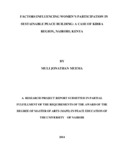| dc.description.abstract | This research study aimed at examining the factors that influence women‟s participation in sustainable peace building in Kibra region; Nairobi County. It was guided by six research questions: One, to what extent does violence against women affect their participation in sustainable peace building in Kibra? Two, how does women marginalization affect their participation in sustainable peace building in Kibra? Three, in which ways do financial constraints, influence women‟s participation in sustainable peace building in Kibra? Four, to what extent does women‟s level of education and training influence their participation in sustainable peace building in Kibra region? Five, how do government structures influence women‟s participation in sustainable peace building in Kibra region? And question six, to what extent does culture affect women‟s participation in sustainable peace building in Kibra region, Nairobi County? Some six hypotheses were established and tested using multiple regression in the data analysis. Apparently, the conceptual framework herein functions as the key platform on which all the research activities for this study were centered. A descriptive research study design was adopted involving mainly the qualitative approaches. An accessible population of 6006 respondents distributed within the 13 villages in Kibra was surveyed out of which a sample size of 25 subjects was interviewed for the relevant data. The key informants in the sample included external peace actors such as NGO staff, the CBOs, DPCs, CSOs, Women group peace builders and Youth peace builders. The selected sample size included the thirteen chiefs in Kibra who were handpicked purposively since they were deemed informative. This sample population was obtained mainly through a combination of stratified random sampling and the simple random sampling techniques since the target population presents in sub groups. The data collection methods used was: interview schedules, focus group discussions and secondary data. Data analysis was done mainly qualitatively through discourse analysis, explanations and discussions. Individual responses were analyzed, compared and categorized with the results of the transcription of the focus group interviews. Finally, statistical tables, frequencies, charts and diagrams were constructed to present the findings of the research for interpretation before conclusions and recommendations could be made. Regression and correlation analysis was used to assess the strength of the relationships between the specified variables. The findings show that several factors falling within violence against women such as: domestic and physical violence, traumatic sexual violence and psychological distress substantially influence women‟s participation in sustainable peace building in Kibra. Marginalization issues facing women were: gender imbalances in politics, economic and social power, exclusion of women in formal peace processes and peace building, and gender-blind approaches to conflict prevention and management. Cultural practices such as women‟s role of bearing children, gender insensitive approaches to peace building, association of women with domestic spheres among others negated women‟s involvement in sustainable peace building. Financial constraints (experienced such as, lean external financial support, delays in financial support, chronic under-funding and poor training on areas of financial and group management) greatly affected women‟s participation in the sustainable peace building process. Lack of resources among women and in access thereto, seriously undermines their peace efforts. Women‟s level of education and training affected their participation in sustainable peace building. Their academic capabilities and skills were grossly and variedly undermined. Institutional factors such as government structures and policies, further, affected women‟s participation in sustainable peace building. The study concluded that violence against women affected their participation in sustainable peace building.
xiii
Concerning women‟s marginalization, the researcher found that women are marginalized in the villages in Kibra since most of the African societies are patriarchal in nature (Kibra is not spared). Some of the factors that perpetuate women‟s marginalization in the community include: gender imbalances in politics, economic and social power. Financial constraints were also found to be a pivotal factor influencing women‟s participation in sustainable peace building processes. Lean financial support, chronic under-funding, poor training on areas of financial and group management were some of the bottle-necks cited as adversely affecting the women groups and much so those involved in sustainable peace building processes in the Kibera slum area. The researcher observed that the level of education and training among women in Kibra was being undermined which negatively influenced their participation in peace-building and their efforts in peace-education campaigns targeting various vulnerable groups in the region. The problem was more acute among government officials organized within the framework of women groups than elsewhere. Some of the recommendations suggested were that: governments must undertake equitable gender policy changes; promote women education, training and regular funding. Initiation of positive institutional changes so as to enhance women‟s participation across a myriad peace processes and even within the existing government structures. It was also felt that, the government should sign national level peace accords and commitments in bid to promoting a peaceful culture of peace, co existence and human security. | en_US |

